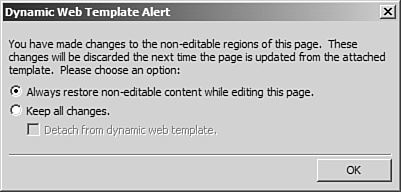Changing Code in an Attached Web Page
| As mentioned earlier in "Creating Dynamic Web Templates," any section of an attached page that is outside an editable region is protected. However, it is still possible to access the HTML source for protected areas of the page. When you do switch to a view of the HTML code for the page, any code outside an editable region will be highlighted as shown in Figure 20.13. Figure 20.13. Code that exists outside editable regions is highlighted in Code view.
If you change any of the highlighted code, FrontPage will display the Dynamic Web Template Alert dialog (see Figure 20.14) warning you that you have made a change to a non-editable region and informing you that it will be changed back the next time the page is updated. Figure 20.14. The Dynamic Web Template Alert dialog will warn you if you make changes outside an editable region.
You have two choices at this point:
|
EAN: 2147483647
Pages: 443

